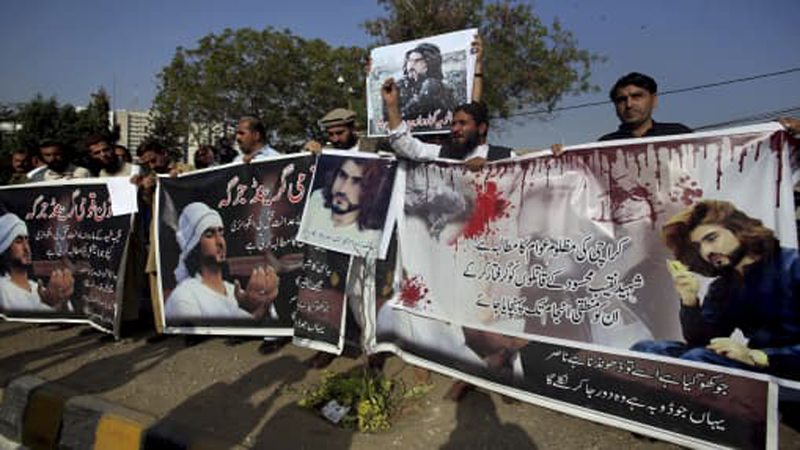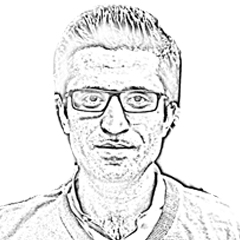Three weeks ago, the Karachi police murdered Naqeeb Mehsud over unwarranted terrorism charges. Naqeeb was a native of Makin, South Waziristan, and resident of the city as his family and he had migrated to Karachi in the wake of military operations in their hometown.
On initial inquiry after the murder, his profile did not fit the preconceptions. Instead, Naqeeb was an ordinary citizen who ran a clothing store and was fond of modelling which to a rational mind did not, in any manner, conform to the ideology of a terrorist.
The subsequent public outcry from the Pashtun community on and off social media compelled the government to set up a committee to look into Naqeeb’s death. The committee found no evidence of his involvement in terrorism or relation to it. The media reports did not see any proof either. Hence, his death turned out to be an extrajudicial murder, one among countless, unreported others.
The only “plausible” reason for Naqeeb’s murder though seemed his ethnic identity as a Pashtun and the fact that he was a migrant from FATA, which has been home to raging conflicts between terrorist groups and Pakistan’s armed forces for well over a decade now. Naqeeb’s murder did not appear to be just due to an irrational bias, but also as a result of the way the Pakistani state has treated ethnic minorities. The hostility that led to his tragic death has been nurtured for well over six decades by the legacy of the state’s suspicion and animosity to the politics of Pashtun nationalists.

The same state has wrongly conflated terrorism with Pashtun culture lately. There is a narrative in place to target them as enemies and treat them as ones to be dealt. So, there is a ‘logic’ that guides the state’s domestic counter-terrorism policy.
Unless there is a will among people to question violence that frequently goes unchallenged in Pakistan, it will be challenging to see fairness and justice in society and a sense of it among those who run it.
Besides Naqeeb’s tragic murder, there are many examples of ethnic profiling of Pashtuns as terrorists. Last year, the Punjab police specifically targeted the Pashtun community in Lahore and Rawalpindi as suspects of terrorism. More recently, after clashes between student unions in Punjab University, the police jailed almost 200 Pashtun, Baloch and Saraiki students on charges of terrorism. The list is long and exhausting.
One may, however, ask why is it that a person from a specific community becomes a target of labelling and violence? The article attempts to answer this question.
A frame is defined as the general ideas or structure that forms the background to something. Kay Whitlock and Michael Bronski, in their book Considering Hate, define frame as a “conceptual path shaping how people understand an issue and what ought to be done about it.” Whitlock and Bronski argue that the language of a specific frame, or its absence, orders the world: “It prioritises events, actions, groups, and beliefs.”
For the sake of clarity, let me also point out here that Whitlock and Bronski use the frame a theory to dissect issues of identity politics, racism and violence in the US. I am borrowing their approach and applying it to racial profiling and brutality executed against ethnic minorities in Pakistan. And, this is precisely why a critical discussion on Naqeeb’s death becomes so essential.
The two theorists argue that the frames of ‘hate’ or ‘terrorism’ in the US are flawed and over-determined, and are used as placeholders to obscure the actual causal factors of structural brutality and violence. For our discussion, it is fitting to use the ‘terrorism’ frame although ‘hate’ is not utterly exclusive if not inevitable. One problem with the terrorism frame is that it predetermines events and provokes a rush to judgment about those events. This way of making events predictable happens because, Whitlock and Bronski argue, “The … frame often provides the only language we have to explain such an event.” Such language labels who is who and who is what and makes it impossible for people to have alternative imaginations.
The Italian philosopher Giorgio Agamben, in the State of Exception, says that after 9/11, the US adopted a set of rules to target other groups under the excuse of dealing with terrorism. He shows that the gaps in the law permit unlawful acts. One sees else but this narrative in Pakistan when it comes to the policy of targeting Pashtun communities as terror suspects.
Whitlock and Bronski stress that the ‘reflexive’ labelling as an explanation reinforces its use, even if the facts do not fit the explanation. Naqeeb’s death perfectly fits this kind of theorising by the state. It encompasses the political system, the media, security and intelligence institutions, police and criminal justice system. In Orientalism, Edward Said argues how knowledge works to reinforce power.
Similarly, Michel Foucault’s knowledge-power argument addresses this point. In Pakistan, the ISPR propaganda machine has done it in the form of documentary films in which the terrorists are shown speaking the Pashto language. Whitlock and her colleague claim, “The very concept of ‘terrorism’ is predicated on obscuring structural brutality and intensifying policing of suspect communities and individuals, purportedly to prevent (and then harshly punish) violence.” Again, the policing of Pashtuns is witness to this xenophobic and hateful framing.
Now the question is how to change this. It is challenging but not impossible. The best place to start is to understand the issue first. And it is not the responsibility of Pashtuns alone, but every peace desiring Pakistani.
One must be clear that terrorist ideology is not confined to a single group of people; it has existed almost in all societies and countries at one point or another in history. In Pakistan, the Taliban or Mujahideen have had people from many nations and ethnic groups, including the Punjabis. It is unfair, therefore, to associate terrorism with a particular community based on how they look, what language they speak and where they live.
The role of media and intellectuals is critical. But unfortunately, in Pakistan, the dominant Punjab province controls most of the press in the country. Hence, it is challenging for minority ethnic groups to get their point across on issues central to their existence and dignity of life.
One example is the pitiable and practically non-existent reporting on matters in Balochistan and FATA where violence and killing in the name of national security continue unabashedly. The media’s recent blackout of the peaceful sit-in by Pashtuns in Islamabad shows its ugly face.
Similarly, the silence of intellectuals from the left in Pakistan over Naqeeb’s death and many other instances of injustice to ethnic minorities before has been pathetic, and need to change if we are to dismantle inequalities in power relationships.
Political change is important. Whitlock and Bronski argue, “Political change … begins with imagination. New realities must be imagined before they are constructed. Imagination is not wishful thinking. It is the first practical step towards articulating new possibilities.”
Further, in Whitlock and Bronski’s words ‘What we need is transformative change, not an expansion of the ‘terrorism’ frame. Such change can occur only by understanding how violence against marginalised and vulnerable communities is inextricably bound to broader social and political systems. This (transformation) cannot happen within the framework of ‘terrorism’ that dominates the public imagination, serving as the only subject of debate.’
They argue that societies not only need policies that are more fair and just but to dismantle structural violence and injustice through laws and political reform, these efforts are to be lasting and efficient, and must also be rooted in cultural strategies that radically influence our imaginations. We need strategies that “set us free to envision alternatives beyond the choices offered us by those in power, that encourage and strengthen ideas of goodness to bolster structural change.”
It would be unfair to argue that Punjab or Pakistan is filled with violence against minority ethnic groups. However, what remains a problem is “…that there are structural elements in the culture (or the body politic of the country) that are integral to promoting and reinforcing social power imbalances. These social imbalances lead to individual and group violence. This violence is often understood to emanate from individual choices, cultural difference, or personal prejudice.” But, according to Whitlock and Bronski, “These individual and personal emotions, ideas, and acts are intimately connected to larger institutionalised structures of power and inequality.” They need to be challenged if we are to live as equal citizens in dignity and harmony.
Unless there is a will among people to question violence that frequently goes unchallenged in Pakistan, it will be challenging to see fairness and justice in society and a sense of it among those who run it.
There is a great need for asking questions. What would it mean to seek justice in the broadest, most profound sense of the word? How does ‘terrorism’ as a political and national security frame shape societal views about specific communities and effective responses to it? Where have we got with such framing, and where will it lead us? And where do we want to go as a nation?
The writer is a Lecturer, Department of English, and Rutgers University; E-mail: aslam.kakar@rutgers.edu
Published in Daily Times, February 7th 2018.
